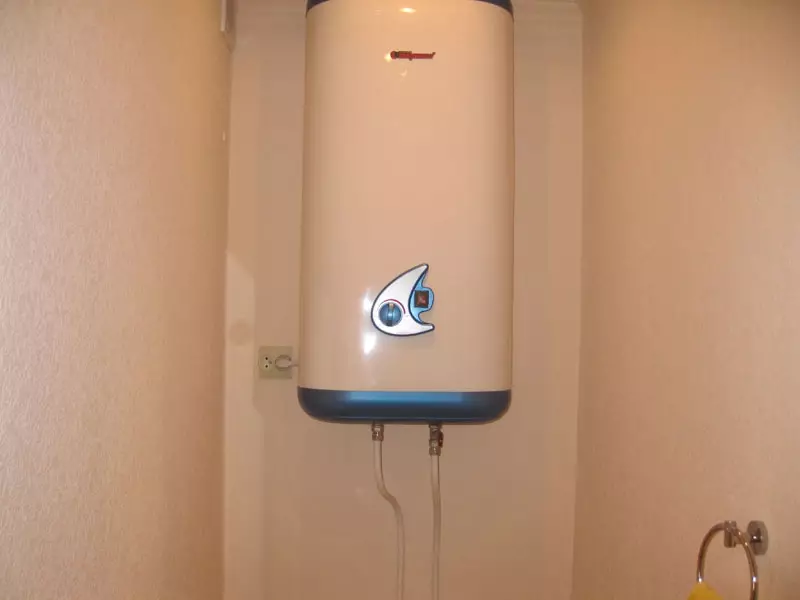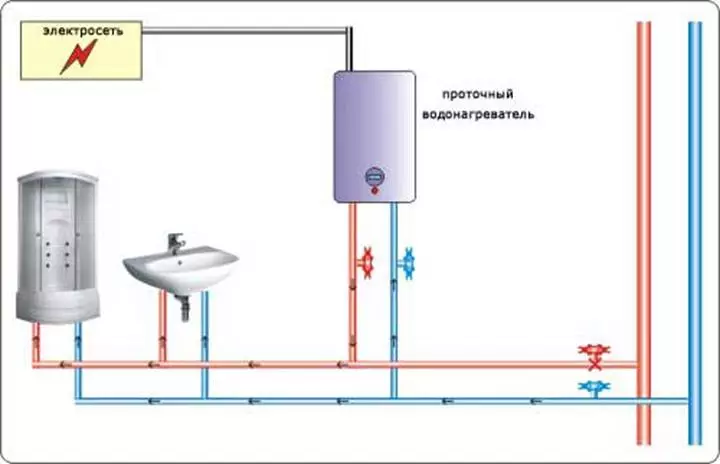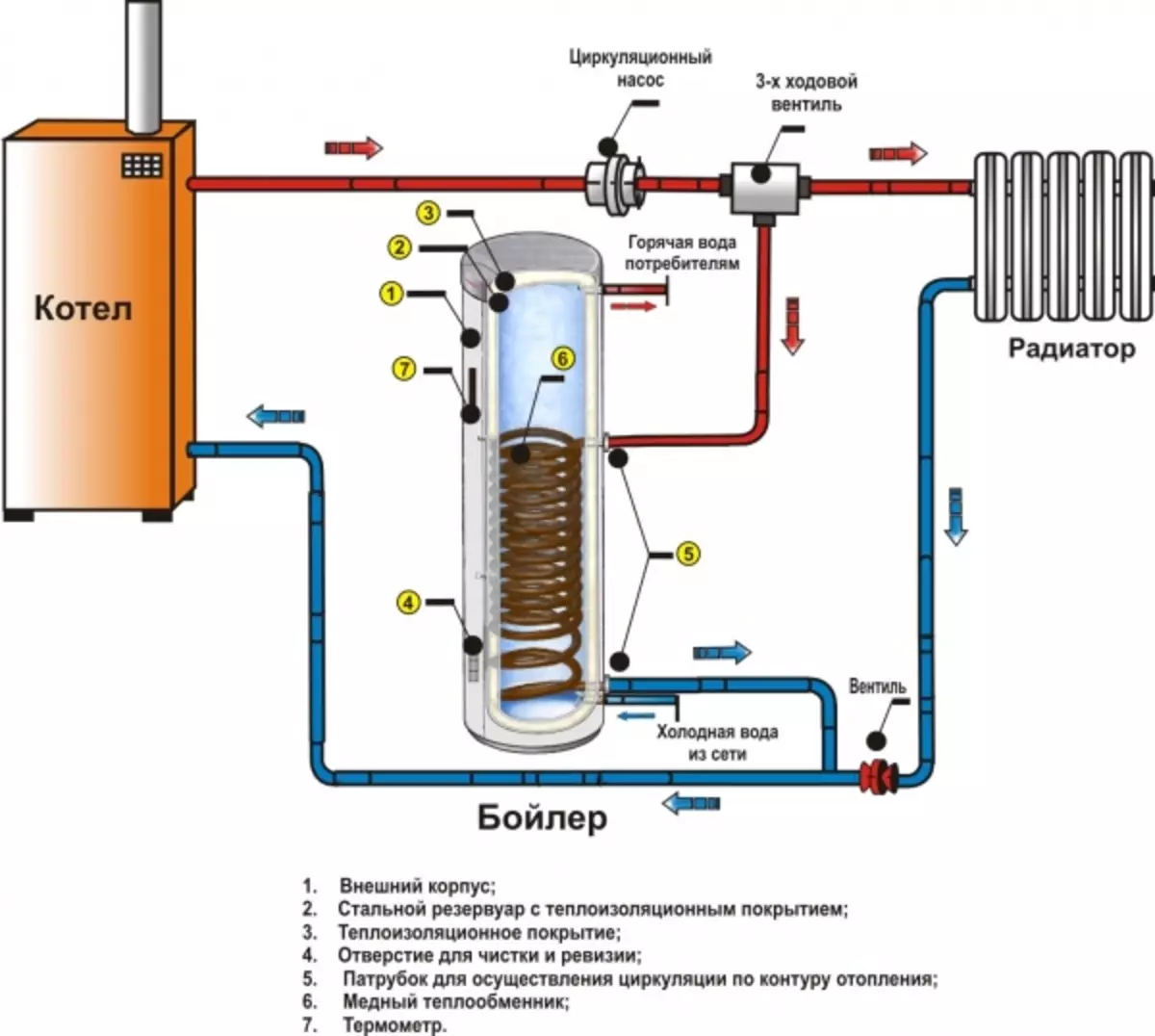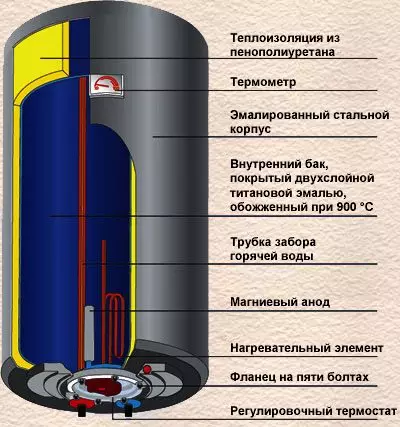Difference of the boiler from the water heater
Modern person got used to comfort. It was already a humorous expression "convenience in the yard", and people seek to surround themselves comfortably, organize the surrounding space in such a way as to feel as comfortable as possible in the house or apartment. One of the main conditions of comfort is the constant presence of warm water. In addition to centralized feed, burdened by a multitude of flaws, hot water can be obtained from a boiler or water heater.

The water heater must be installed in a spacious easily accessible place.
What is a boiler?
It is a container filled with water heated using a heat source.
In other words, this is a storage water heater, that is, the accumulated water is heated, and not running.
Varieties of boilers existing today
Main types according to the water heating method:

Diagram of the installation of a flow water heater.
- electrical;
- Gas: with an open combustion chamber (using natural traction); with a closed combustion chamber (using forced traction);
- indirect heating (those that use the boiler power);
- Combined - use gas and electricity.
By the water supply method:
- pressure;
- Non-perm (can be used in the absence of water supply).
By installation method:
- outdoor;
- Suspended (divided into vertical and horizontal).
In the form of a tank:
- Round (in the shape of a cylinder);
- oval (in the form of an oval rectangle);
- Other forms.

The scheme of the boiler of indirect heating.
The electric boiler consists of a metal tank, a tan (thermal electric heater), magnesium anode and thermostat. The magnesium anode is used to protect against corrosion inside the tank. The surface of the tank outside is covered with a layer of heat insulating material. Depending on the model, additional elements may be present.
Principle of operation: TEN, placed inside the tank, heats the water. Cold water supply is carried out below, the withdrawal of hot water is top. The pressure in the water supply system pushes heated water, and that enters the point of use. The thermostat controls the water temperature (the user itself specifies this parameter by changing if necessary), heating water to a specified value and maintaining the temperature by turning on and off the Tan.
Article on the topic: Stands for a washing machine
The advantages of the electric water heater are: lower cost, simplicity of installation, no chimney need, the ability to install in any convenient place, even under the ceiling (suspended horizontal boilers are designed for this).
The electric boiler connects to the household power grid, so it is convenient to use it in the house, in the apartment, at the cottage, in small enterprises for household purposes.
Gas boiler. The principle of operation is the same as the electric, only heating of water is carried out from the gas burner.

Electrical boiler connection diagram.
To install it, you need to make an additional output to the chimney, and this complicates the installation and affects the location of the device. The boiler with a closed combustion chamber (using forced craving) can be installed in the outer wall with the output of combustion products through a special hole in it.
Advantages: With a greater cost of buying and installing a gas boiler costs cheaper during operation, since the gas price is significantly lower than electricity. Another advantage is greater power relatively with electric. This allows you to quickly heat the water to the desired temperature, so you can purchase a boiler a little less capacity for the same needs. Disadvantages: it is impossible to arbitrary placement, additional documentation is needed for installation, and the main gas is not everywhere.
Boyler of indirect heating. It may be an addition to the one-contact boiler. Cylinder-shaped container can be installed vertically or horizontally depending on the model. Inside the capacity placed the heat exchanger tube, which has a complex shape (more often a snaking). According to this pipe, the coolant circulates, which heats the water.
There are models without heat exchanger tubes. Such a boiler consists of two vessels inserted one in another. In the inner vessel is heated water, and the exterior circulates the coolant.
Principle of operation: Cold water enters the capacitance of the boiler through the input, in the heat exchanger coil or between the double walls of the case circulates the heat carrier fluid heated by the heating boiler. It warms the incoming water in the boiler and supports it at a constant temperature. Each indirect heating boiler has no pipes of input and output connecting it with a heating boiler, and hot water enters the consumer through the output tube.
Article on the topic: Design, new products and selection of short curtains for the bedroom
Advantages:
- high performance;
- The coolant fluid is specially prepared, due to which its negative impact on the heat exchanger is reduced;
- You can use various sources of thermal energy, as well as switch if necessary from one to another (there are boilers with built-in TEN).
Disadvantages:
- High cost of equipment and installation (specialist invitation is required);
- When heating a large amount of water, less heat comes for heating;
- The installation must be manufactured in a special room (boiler room).
Water heaters flowing - speakers
The device and the principle of operation of these devices is somewhat different from the accumulative. In flow-type heaters, the water is not heated in the tank, but passing through the heating element. A gas burner, a tang or an uninsulated spiral can be performed as a heating element. It is clear that water is heated in seconds, and its volume is not limited to the tank capacity. As soon as the crane opens at the point of water intake, the water heater is automatic on and the water heating begins.Such water heaters can be open (non-patient) or closed type (pressure). Performance can only work with a single mixer output, and pressure - for multiple water flow points.
Non-free water heaters should be equipped with special mixers, but their installation is very simple, and the same simple dismantling is possible. Dignity - low cost. Therefore, it is better to use them as a seasonal water heating device or in fitted rooms, for example, in the country.
The difference between the accumulative water heater from the flow
When operating, the flowing water heater has several advantages, namely:
- Reparatively small size and weight.
- No restriction of the volume of heated water.
- Energy savings (consumption only for heating, and not to maintain temperature).
But there is also a number of inconveniences:
- When you open a hot water crane, you need to drain the cold, the one that was in the column before the start of heating. The temperature adjustment does not occur immediately, and from the crane can splash with hot water. And so with each opening of the crane. That is, when saving energy is embossed water.
- The water temperature changes when consumption changes, as well as when changing the pressure in the plumbing. In practice, it is fraught with situations when, taking the usual shower, you find yourself in contrast. But in the case of a bath filling it will be unnoticed.
- Power. For the electrical column, we need a modern, reliable wiring with special fuses, and more powerful models need a three-phase power grid.
Article on the topic: Water warm plinth with your own hands: Heating homemade board, electric
In practice, the choice of a cumulative water heater gives greater comfort. And lovers of simplicity prefer columns. From the variety of types of types and models of water heating devices represented by the sphere and models, you can only choose the most suitable for home and family for your needs and conditions.
